






 |
||||
 |
 |
 |
 |
 |
 |
||||
|
It Takes a Village — Charles Village — to Make a College Town
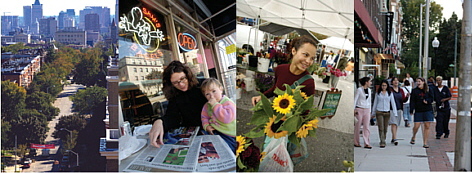 Some funky shops? A greasy slice? How about a little night life? For Johns Hopkins students, a neighborhood boom might be just what it takes to turn Homewood into home.
By Maria Blackburn Baltimore is a city of distinction, a city of names. At one time or another this fair metropolis has been called Charm City, Queen City, Mobtown, and Crabtown. It's also been termed (formally or otherwise) The City that Reads, The City that Breeds, The City that Bleeds, The City that Believes, and The Greatest City in America. But to date, one title has eluded it: College Town.
"There's nowhere you can go and buy a huge slice of greasy, cheap pizza to eat on the street," says Ben Tilghman, a history of art graduate student. "Where are the funky shops that sell clothes, books, and posters? How about more places near campus where you can see great bands?" "I wish there were more coffee shops and trendy shops like Urban Outfitters," says Natasha Singh, a junior majoring in political science who is from Dallas. "A pool hall would be nice," Chris Ecker, a junior computer science major from Boston, says with a small sigh. And please, could some businesses at least try to stay open past 6 p.m.? asks Chethan Mallela, a sophomore economics major from New Jersey. "When I come out of the gym at 10 p.m. and I want to get something to eat, the only thing that's open is Subway."
"Baltimore is a town with colleges," says Jerry Gordon, owner of Eddie's Market in Charles Village and a native Baltimorean. "Boston is a college town." But recent developments could mean an improvement in Baltimore's college town status, at least in Charles Village, the campus neighborhood. In September, Hopkins opened the doors to Charles Commons, a 618-bed residence hall complex that boasts a 29,000-square-foot full-service Barnes & Noble on its street level. One block south on St. Paul Street, developer Struever Bros. Eccles & Rouse is developing two other projects, Olmstead and Village Lofts, that will add 177 condominiums, 27,500 square feet of restaurant and retail space, and a 395-space public parking garage.
Some 4,000 to 5,000 college students, mostly from Hopkins,
live in the several blocks around Charles Village. Until
now, those students have not had much of an opportunity to
interact with their neighbors, or with other students off
campus — other than at parties. "A party at 3 a.m. is
not the best time and place to discover the richness of
other students," says
Paula Burger, dean of undergraduate
education at the Homewood campus. With the Charles Village
development, "the idea is to have a place where students
want to hang out, where they don't always have to get into
a cab and go to Fells Point," she says. |
|
| Charles Commons at right. Learn more here. |
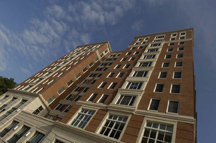 The hope is that the three blocks of St. Paul Street
between 34th and 31st Streets will draw students from
Hopkins and other area colleges together with neighborhood
residents and create the vitality that's been missing.
The hope is that the three blocks of St. Paul Street
between 34th and 31st Streets will draw students from
Hopkins and other area colleges together with neighborhood
residents and create the vitality that's been missing. "Charles Commons is just the beginning of a renaissance in Charles Village," says Burger. "The plan is to have wider sidewalks so that people can dine outside and walk and shop and be in the street and feel safe. We're not just investing in buildings. We want to develop a little urban oasis." But if you build it, will they come out of the library and the fraternity parties and into the community? That is what remains to be seen.
Ask 10 people to define "college town" and you're likely to hear 10 different answers, heavily influenced by where they went to college. For some, it's a small town in the middle of nowhere that blossoms into its own city each semester. Think Chapel Hill, North Carolina; Middlebury, Vermont; and Bloomington, Indiana. For others, it's a place where the college is part of a community's fabric, but not its sole reason for being. Here we'll offer Madison, Wisconsin; Ann Arbor, Michigan; and Austin, Texas. "I think a college town is a mix of community members and students living a vibrant lifestyle," says Kristen Campbell, executive director of the Baltimore Collegetown Network, a consortium of 16 colleges and universities in greater Baltimore. "It's a good place to go to school and a good place to live."
Blake Gumprecht, a University of New Hampshire geographer
who is writing a book on American college towns, defines
them as "any city where a college or university and the
cultures it creates exert a dominant influence over the
character of the community." He is deliberately imprecise,
he says, because "there is not a clear distinction between
a college town and a city that is merely home to a
college." |
| Eddie's shows its Hopkins spirit. |
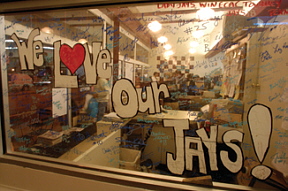 "Under Gumprecht's definition, Boston wouldn't make the cut
as a college town," notes Robert Karrow, editor of
www.collegetownlife.com. His Web site links to news
stories
from college towns across the country as well as sites like
www.epodunk.com, which lists the best college towns.
(No,
Baltimore does not rank there.)
"Under Gumprecht's definition, Boston wouldn't make the cut
as a college town," notes Robert Karrow, editor of
www.collegetownlife.com. His Web site links to news
stories
from college towns across the country as well as sites like
www.epodunk.com, which lists the best college towns.
(No,
Baltimore does not rank there.) "I tend to think of college towns as walkable, grid-layout neighborhoods near a campus with a mix of building styles and ages," Karrow says. He would expect a college town to have a business district with living space above street level commercial; a majority of locally owned/developed businesses; readily available arts and sports opportunities; a weekly farmer's market; housing options for a mix of economic levels; and families, singles, and students living in relatively close proximity. Sounds like Charles Village. It also sounds like the kind of college town Adam Falk remembers as an undergraduate at the University of North Carolina at Chapel Hill. But he also remembers a feeling of community. Falk, dean of the Krieger School, didn't just have an apartment off campus in Chapel Hill, he lived there. He rode his bike two miles to class, frequented the neighborhood post office and grocery store, and even did the taxes for the Chinese immigrant family next door. "A college town isn't just about entertainment and recreation," he says. "It's about how you feel when you walk out the door at 9 a.m. to go to class. When you walk the four blocks to campus, you don't just feel like you are passing through. You feel like you are part of the neighborhood. It's about being rooted. Right now, our students live in Charles Village, but they are not rooted there."
A lack of collegiate atmosphere wasn't always much of a concern for Hopkins. In fact, for years, the university encouraged its students to focus more on campus than on the community for their life outside of class. As an undergrad in the early 1950s, Simeon Margolis, A&S '53, Med '57, Med '64 (PhD), played varsity basketball and baseball, was president of several student groups, and lived in a fraternity house after freshman year. "I was so busy doing those things and taking pre-med courses I didn't really need anything else," says Margolis.
In the early 1980s, then-university President Steven Muller
suggested developing the area with a bookstore, a pizza
place, and a couple of restaurants "where students could go
to hang around and feel safe and not disturb anyone," says
Jerry Schnydman, A&S '67, who was director of undergraduate
admissions when Muller was president. But nothing happened.
"Back then, we just didn't have the same number of students
as we do now," says Schnydman, now executive assistant to
the president. Plus, the university's relationship with its
neighbors was less than ideal. "It was them versus us," he
says. |
| Carma's Café |
 Since 1987 the number of Hopkins undergraduates has almost
doubled, from 2,400 to 4,200. Over the years those students
became increasingly dissatisfied with the fact that campus
housing was so limited that juniors and seniors had to live
off campus, where they often felt disconnected and
disassociated. They yearned for something beyond classes,
late night library study, and double lattes at Café
Q.
Since 1987 the number of Hopkins undergraduates has almost
doubled, from 2,400 to 4,200. Over the years those students
became increasingly dissatisfied with the fact that campus
housing was so limited that juniors and seniors had to live
off campus, where they often felt disconnected and
disassociated. They yearned for something beyond classes,
late night library study, and double lattes at Café
Q."The single most important undergraduate need for Johns Hopkins is to strengthen the sense of community," the final report from the Commission on Undergraduate Education (CUE) stated in May 2003. Ninety percent of Homewood's juniors and seniors said they would be likely to live in dormitories, according to the CUE report. With limited space on campus, Hopkins needed to expand into the community. After decades of focusing only on campus, administrators began looking outward. "There's a greater recognition at many colleges and universities across the country that they are part of the larger community," says Martha J. Droge, who works for Ayers/Saint/Gross, a Baltimore architectural and planning firm that has created master plans for more than 40 colleges and universities nationwide, including Hopkins. "To be connected to that community in a positive way is beneficial for the faculty, staff, and students on campus, as well as the community as a whole." Concentrating 600-plus Hopkins undergrads on Charles Village's main commercial drag will bring them physically closer to their neighbors. But to really connect, they need interaction. That's why creating a lively neighborhood atmosphere is so important, Falk says. People might be drawn by the big Barnes & Noble, but they'll also come for the scene: outdoor dining; excellent lighting; safe streets; and lots of people walking, talking, eating, and shopping. "There's going to be a transformation," says Hopkins Dean of Student Life Susan Boswell. "All of a sudden, there will be a street life that hasn't existed before."
The Johns Hopkins University has a stellar international reputation. Applications are up. And across the nation, urban universities are more popular than ever. Yet Hopkins is losing bright students to Duke, Penn, Georgetown, and Cornell. Location is a big factor, says William Conley, dean of enrollment and academic services for the Homewood campus. "Baltimore itself is not a destination city for college students. It's a place that doesn't have a mindshare in 17- and 18-year-olds as a college town. Students who come here do so despite what they think Baltimore is." "Nobody is in love with Baltimore," agrees Jennifer Zosh, a graduate student in the Department of Psychological and Brain Sciences who sometimes pines for the college town atmosphere of the University of Delaware, where she was an undergraduate. "I didn't come here because I wanted to come to Baltimore. I came because of the Hopkins faculty." Though undergraduate applications at Hopkins are growing faster than at any of the university's peer institutions (some 13,900 students, 23 percent more than last year's record number, applied to Hopkins in 2006), convincing top students to come here is still a problem. "At Hopkins, 33 percent of students who are accepted actually enroll," says John Latting, director of undergraduate admissions. That number, known as the yield, hasn't changed in several years. "Among our competitors, the yield is 40 to 60 percent. Harvard's yield is 80 percent." The importance of a college's surroundings to a prospective student has been growing, says Latting. "People are often surprised that campus surroundings are not an afterthought," he says. "For some students it's actually a driving factor." In this department, Baltimore doesn't rate so well. When undergraduates admitted to Hopkins last year were asked to rate campus surroundings, 31 percent of non-enrolling students said they were "poor/fair." By comparison, only 18 percent of enrolling students called the surroundings "poor/fair" and 20 percent called them "excellent." Humanities students — a group the Krieger School is trying to attract — are especially choosy, Latting says. A recent survey of admitted students interested in the humanities who did not enroll at Hopkins was revealing. One student wrote: "The reason I did not end up attending Johns Hopkins was the physical campus and location.... I felt that Baltimore, after growing up in Los Angeles, did not provide me with adequate abilities to explore. Simply enough, I feared I would get bored outside the classroom." Another commented: "For me the city of Boston was an X-factor. Despite BC's shortcomings in academics when compared with Hopkins, I could not help but feel that I would receive a more full college experience at Boston College. The decision was difficult, and some people still can't believe I turned down Hopkins for BC." Conley sees this as a teaching opportunity. "Even if students didn't come to Hopkins because of Baltimore, we still have an opportunity to introduce them to Baltimore and make it an experience," he says. "You can't create Harvard Square or Greenwich Village or Westwood Village, but you don't have to. It doesn't take a city to make a village. It can be a very small, localized environment."
Anyone who has ever lived next to a college knows the less-than-pleasant realities: late-night parties, shabby rentals, nonexistent on-street parking, the simmering bad feelings that the college gets to do whatever it wants and the neighbors can do little to stop it.
"There's often this tension," says Sandy Sparks about
living near the Homewood campus. Adds the longtime Charles
Village resident and neighborhood activist, "But that's
what makes it interesting." |
| The hustle and bustle of a college town. |
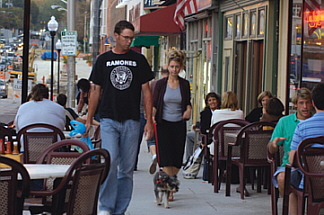 Charles Village is a vibrant neighborhood full of people
from many different backgrounds and income levels. Says
Gordon, owner of Eddie's Market, "It's a very eclectic mix
of professionals, artists, writers, musicians, and
families. But they all could be wearing T-shirts so you
don't have any idea what people do for a living."
Charles Village is a vibrant neighborhood full of people
from many different backgrounds and income levels. Says
Gordon, owner of Eddie's Market, "It's a very eclectic mix
of professionals, artists, writers, musicians, and
families. But they all could be wearing T-shirts so you
don't have any idea what people do for a living."The neighborhood has had problems. In the late '80s and early '90s, about the same time Hopkins enrollment was on the rise, crime in Baltimore was increasing. "For many years, the Hopkins administration was wary of crime in Charles Village but unwilling to engage with the streets east of campus, so all they did was issue warnings about being alert, not renting east of Greenmount Avenue, etc.," says Neil Hertz, a retired professor of humanities and English at Hopkins who took students into off-limits neighborhoods as part of his popular course on the city and its history. In this period, property values across the city were decreasing. When Hopkins opened several new campus dorms, a drop in student demand for off-campus rentals likely drove down values in Charles Village even more. Residents wanted to liven up the neighborhood with pedestrian-friendly retail, but a 1971 zoning code severely hampered development efforts.
"How can we make something happen?" Sparks remembers
asking. At the time she was the executive director of the
Greater Homewood Community Corporation (GHCC), a nonprofit
founded in part by Hopkins and devoted to strengthening
Baltimore's north-central neighborhoods. In the early '90s,
a GHCC neighborhood relations committee got the city to
legislate the creation of the North Charles Village area as
a planned unit development (PUD), which allowed for
expanded retail development. Hopkins administrators were
enthusiastic. They had been considering renovating the
Homewood Apartments and wanted to add retail. Working with
the PUD, they developed the cluster of shops that became
known as Hopkins Square. Through this early project, "we
developed a good working relationship with Hopkins and the
Hopkins real estate office," Sparks says. "Hopkins did a
complete 180-degree turnaround. They realized they needed
to be woven into the neighborhood fabric." |
| Waverly Farmers Market |
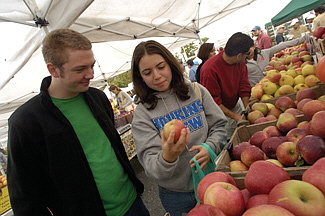 This working relationship continued when Hopkins and
Struever Bros. hosted a large community meeting in spring
2002 to share plans for a 313,000-square-foot bookstore and
dormitory in Charles Village. The conversation continued
over the next 18 months during a series of community
meetings.
This working relationship continued when Hopkins and
Struever Bros. hosted a large community meeting in spring
2002 to share plans for a 313,000-square-foot bookstore and
dormitory in Charles Village. The conversation continued
over the next 18 months during a series of community
meetings. This was a huge shift, says Dawna Cobb, a member of the Charles Village Civic Association who has lived in the neighborhood for 20 years. "When these projects were being envisioned, the folks from Hopkins reached out to leaders in Charles Village. They came and asked us what we wanted to see in the neighborhood," she says. "I thought, 'Wow, this is great — they are seeking our input.'" Though residents and business owners liked the idea of a big bookstore to draw people and other retailers, some had reservations about Charles Village becoming little more than an outpost of the Homewood campus. That distinction became clear to Struever Bros. development director Dominic Wiker, A&S '93, back in 2002 when he showed concept plans for the Charles Village Project in the community meetings. The project was then known as College Town. People hated the name.
"The neighbors made us more aware of their sensitivities,
and that was a good thing for us to understand," says
Wiker. "There was a lot of concern early on that we were
going to create a merchandising mix of things that only
20-and 30-year-olds would want. They saw the name as part
of
that." |
| St. Paul at night |
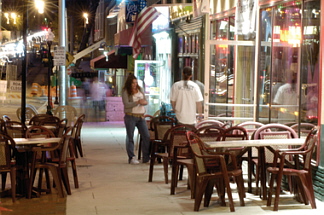 Neighbors shared their other preferences with Hopkins and
Struever Bros.: sufficient parking; wide sidewalks; street
traffic that wasn't overwhelming; and small, independent
stores and restaurants.
Neighbors shared their other preferences with Hopkins and
Struever Bros.: sufficient parking; wide sidewalks; street
traffic that wasn't overwhelming; and small, independent
stores and restaurants.For many, one of the main concerns was that the new businesses not hurt the older ones, especially those in the 3100 block of St. Paul Street, home to Eddie's, Donna's restaurant, and the Charles Village Pub, says John Spurrier, a real estate agent and vice president of the Charles Village Civic Association. "Ideally, the businesses that would come would complement, not compete with, the existing businesses. Most of the merchants there have been in the community a long time, and we wouldn't want them to lose business because of this."
Wiker says that five businesses have signed leases for the
Charles Village Lofts retail space: Chipotle, Cloud 9
Clothing, Starbucks, Cold Stone Creamery, and University
Gourmet. The developer also hopes to sign a local
stationery store, which would make the mix of retailers
half local and half national. The Olmstead will house
Homewood Florist, a Royal Farms relocated from the Charles
Commons site, and other businesses, such as a wine bar and
a cafe, to be determined. While some neighbors aren't
thrilled with the prospect of chains, Wiker says that the
plan from the beginning was to include both national and
local retailers. "Diversity and density — that's what
we're going for in an urban area," Wiker says. |
| Charles Village's "painted ladies." |
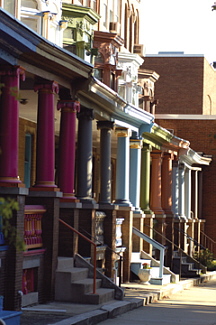 Carma Halterman opened her artisinal coffee shop, Carma's
Café, on a shady corner of 32nd Street between
Charles and
St. Paul in 2004, and has built a loyal following with her
homemade yogurt, granola, and soup. The fact that she'll
soon be competing with several coffee shops —
including a Starbucks — concerns her, but she says
she's confident that as Charles Village becomes a
destination point, all of the businesses there will
benefit. And she values the relationship the neighborhood
has forged with Hopkins. "I don't think becoming a college
town is what's desirable," Halterman says. "I think what's
desirable is for colleges and universities to become equal
partners in the community so that they both bring out
what's best in each other."
Carma Halterman opened her artisinal coffee shop, Carma's
Café, on a shady corner of 32nd Street between
Charles and
St. Paul in 2004, and has built a loyal following with her
homemade yogurt, granola, and soup. The fact that she'll
soon be competing with several coffee shops —
including a Starbucks — concerns her, but she says
she's confident that as Charles Village becomes a
destination point, all of the businesses there will
benefit. And she values the relationship the neighborhood
has forged with Hopkins. "I don't think becoming a college
town is what's desirable," Halterman says. "I think what's
desirable is for colleges and universities to become equal
partners in the community so that they both bring out
what's best in each other."
The proof that the new Charles Village will be a success didn't come with the arrival of the students in Charles Commons in September or the opening of the new bookstore in October, and it won't come with the line of people waiting to buy burritos at Chipotle in December. It's going to take longer than that.
"The real measure of success will be one or two years from
now," says Struever Bros. co-founder Bill Struever. "For
me, it's being able to walk into a coffee shop or Barnes &
Noble and see young people and old people, people from the
neighborhood, school kids, Hopkins students and faculty,
and nurses from Union Memorial enjoying being in the city
in a delightful and distinctive urban neighborhood, and
just loving life." |
| Donna's Café |
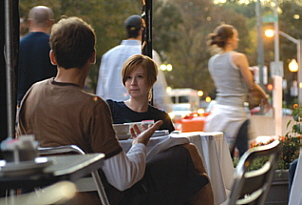 This is not Harvard Square. Or Charlottesville. Or even
Georgetown. It's Baltimore, hon: artsy and analytic,
traditional and eclectic, a small city that's also a small
town. It's urban and near the water. It's quirky. And it's
filled with a diverse collection of well-educated,
creative, forward-thinking types.
This is not Harvard Square. Or Charlottesville. Or even
Georgetown. It's Baltimore, hon: artsy and analytic,
traditional and eclectic, a small city that's also a small
town. It's urban and near the water. It's quirky. And it's
filled with a diverse collection of well-educated,
creative, forward-thinking types. It's Charles Village. Today's students can already see the possibilities. "Everyone rags on Baltimore, but I think it's a great city," says Elena Fedyszyn, a sophomore from Newport, Rhode Island. "Boston is stuck-up. Providence is cool but expensive. In Baltimore, the food is amazing, you can go shopping, and there are tons of museums. People at Hopkins love to complain about Baltimore, but I love it." As Baltimore's reputation as a college town grows, so too does Hopkins' status as a hip place to go to school. That's a realization that has students like junior Jake Dalpiaz feeling just a little bit jealous. "After I graduate, Hopkins is going to be really cool," he says. Maria Blackburn is a senior writer for Johns Hopkins Magazine.
|
 |
|
 The Johns Hopkins Magazine |
901 S. Bond St. | Suite 540 |
Baltimore, MD 21231
The Johns Hopkins Magazine |
901 S. Bond St. | Suite 540 |
Baltimore, MD 21231Phone 443-287-9900 | Fax 443-287-9898 | E-mail jhmagazine@jhu.edu |
|